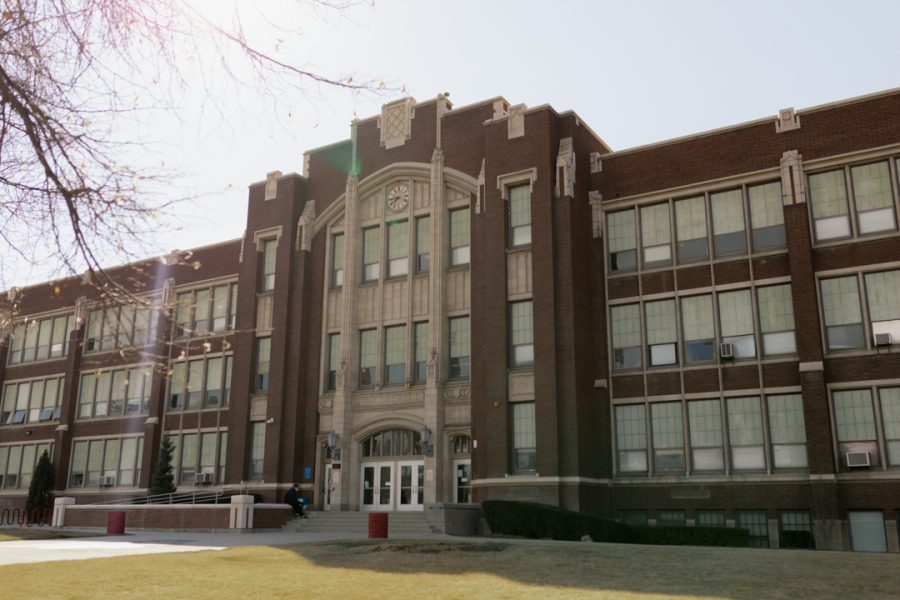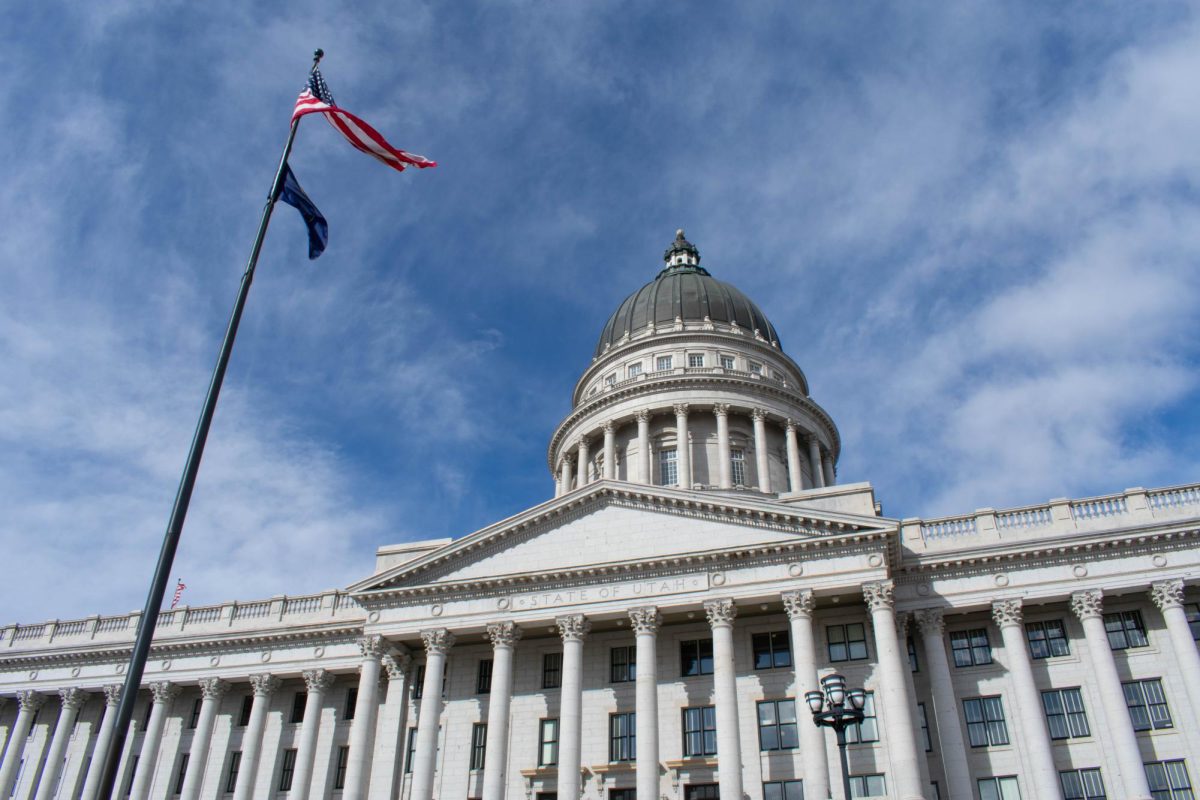Poma: White Saviorism in Education Hides in Plain Sight
West High School Thursday afternoon in Salt Lake City (Photo by Maya Fraser | Daily Utah Chronicle)
April 22, 2021
Conversations about racial discrimination against Black, Indigenous and people of color ask us to reflect on our own social privileges and experiences with racism. True reflection means examining every facet of our lives — especially our academic environments. White saviorism among educators in BIPOC communities, to start with, urgently needs to be checked. As the Salt Lake Valley grows more diverse, white teachers and school leaders must become comfortable addressing their own racial biases and work to deconstruct white saviorist mindsets and assumptions. They need to learn to bridge disconnects between themselves and their racially marginalized students to be truly effective educators.
While there’s no neat dictionary definition of the term, the white savior complex generally refers to white people going into BIPOC spaces for self-serving purposes. According to Contemporary Racism, these purposes include “to somehow prove that the White person isn’t racist, to boost their own ego, and most alarming, to attempt to ‘save’ people of color and get them out of unfortunate circumstances.”
White educators who teach in minority communities can easily fall into a mindset that resembles this definition. White teachers working with students of color are often praised as “heros” or philanthropists for doing so, when they should just be praised for entering a field as demanding as teaching. Whiteness does not automatically make someone more qualified to teach students of color, just as being of a certain race does not dictate a person’s intellect or lack thereof.
This attitude does more harm than good. As a Latina, I got “checked in on” by my white teachers more often than others to see if I understood the material. They would then be surprised and praised me when I performed well, even though that same accomplishment was expected of my white peers. One teacher reaffirmed to me (or to herself) that I did not, in fact, need her help, which was an odd statement that I didn’t understand until later on. These doubts about my intellect have made me feel I have to prove I know what I’m doing, whether through raising my hand too often in class or not asking for help when I need it.
These unchecked toxic attitudes among white teachers have long-term effects. Study after study shows white teachers have lower expectations for students of color, which greatly affects their motivation and achievement. The biases white teachers have about people of color also impact expulsion and discipline rates and many other facets of students’ academic experience.
To be clear, there’s nothing inherently wrong with white teachers wanting to work with and support students of color, so long as it’s done in a good mindset. However, data shows that teachers of color benefit not just students of color, but students of all backgrounds simply because they have higher regard for all of their students. But teachers of color are few and far between, which presents a problem when we look at how white teachers navigate BIPOC spaces.
There is a disconnect between white teachers and students of color, and white teachers are largely unprepared for the teaching environments they encounter. An academic article titled “I Can’t Be Racist — I Teach in an Urban School, and I’m a Nice White Lady!” opens with an anecdote from one of the white authors, who was a recently licensed teacher. When her first job was in a majority Latinx classroom, she says that she “had no idea how to acknowledge my whiteness and their brownness and what that meant to them or me.” This lack of awareness makes it extremely difficult for students of color to relate to their teachers and vice versa.
This issue is not going to go away — there is real work and progress to be made that seldom gets acknowledged. And Utah should be engaged in this reckoning between teachers and students — we are not exempt from this problem. According to a 2014–15 survey, 76% of Utah teachers are female and 88% are white. Those numbers do not correlate to Utah’s increasingly diverse student populations. Last year, after the murder of George Floyd, Yan’Tu Barber, a Black fifth-grade teacher in Jordan School District, noted that none of his colleagues seemed to address the tragedy or racism in general, so he felt responsible to do so alone. During this year’s Black History Month, a Utah school initially allowed parents to opt out of being taught about BHM. Utah schools have a hard time having these basic conversations about racism with students. How can we expect to then address white saviorism among faculty?
It starts by not treating racism as a taboo topic in Utah schools, as well as advocating for students of color. This includes anything from being open to difficult conversations to broadening what students read, from different historical narratives to new primary sources. Teachers should be openly anti-racist and think critically about how their privileges and biases affect their students. Tony Zani, a teacher at Rose Park Elementary said in a Deseret News article, “…we aren’t trying to be colorblind. We are working to reject racism and to honor every student’s race and culture. Students at Rose Park are more invested in school because the teachers honor the students for exactly who they are.” Institutions should also be open to reforming outdated curriculum and make time to address racial biases and issues among faculty. Facilitating workshops and hard discussions about teacher positionality and race should not be simply encouraged but enthusiastically implemented into teacher education.
White saviorism starts with the mindset of any white individual who enters BIPOC spaces — it isn’t solely a systemic issue. By examining ways to connect with students of color and address racism within the academic sphere, white teachers can enter their diverse classroom with a better, clearer mission. In the words of activist Lilla Watson, “If you have come here to help me, you are wasting your time. But if you have come because your liberation is bound up with mine, then let us work together.”












Caleb Mansure • Apr 27, 2021 at 10:27 pm
You all seem to be missing the point of the article. It’s like you didn’t even read it. Some of you speak of love and rightly so we should all love our neighbor. But the point the article is making is that some (some mind you) white teachers have the wrong motivation. The motivation behind some teachers as stated in the article is “to somehow prove that the White person isn’t racist, to boost their own ego, and most alarming, to attempt to ‘save’ people of color and get them out of unfortunate circumstances.”. This is inherently racist and does not treat everyone equally. If you are going into a classroom of people of color and before you have even met them or attempted to teach them anything you have already assumed they are slower, or less educated, or anything at all really you are not only racist, but judgmental and not loving your neighbor by assuming negative things about them based on their skin color. You need to get off your high horse and read the article again because you clearly didn’t comprehend it the first time. I fail to see anywhere in this article the author stated that you shouldn’t love your neighbor or shouldn’t treat people equally if anything it stated the exact opposite. Don’t love people differently because of their skin color. My goodness John Hedberg you missed the point of the article I can’t fathom how you got don’t love people out of this article.
Cory Boren, oh man you really ought to proofread your comments bud a child could have written that. But let’s get to your so called arguments. First you say the author paints white teachers as “ignorant supremacists”as something that is incorrect in this context yet there are multiple sources cited that show white teachers have lower expectations for students of color. Does this mean they are racist in every sense of the word? No, not by any means, but in this context and for this issue it is quite clear that white teachers tend to be racist. You also say that the author says ” Latino and Black communities as incapable of improving their station”. No where in the article is this stated or alluded to. Your next several arguments, are laughable and all fall under the denying the antecedent logical fallacy, basically meaning you are inferring the inverse from the original statement and that somehow makes it true and a valid argument, which is obviously isn’t because all logical fallacies are jokes and are not arguments in any way to anyone with common sense to see through them. Finally you attempt, very poorly, to insult the author and then talk about West High school. The ironic thing here is in the very comment section you post your attempt at an argument in, another person states how they went to West High School and saw a version of the very thing talked about in the article debunking your final argument. In short all of your arguments are easily taken apart and futile attempts to criticize the article.
You all clearly need to read the article again, do some other reading, think before you write a comment. The entire point of the article is that some not all white teachers can go into the classroom full of kids of color with the wrong motivation, racist preconceptions, and even the good people who have the right motivation and do their best have a hard time connecting to their students of color and vice versa. It’s not all the white teachers, it’s not every white person’s fault. But if we are going to tell others to step up then you better be damn ready to step up yourself because if you aren’t then you have no right to ask it of others.
Cory Boren • Apr 27, 2021 at 9:10 am
Yes, but is white savior complex a problem in Utah? I believe you opinion seriously short changes the motivation of most Utah teachers and our minority communities. After reading some critical race paper and quick stroke of your pin, you paint most white teachers as ignorant supremacists and Latino and Black communities as incapable of improving their station. Moreover the inverse of your argument that states we need minorities teaching minorities, is that we need whites teaching whites. What is the point, how does this help? Utah schools have many problems and drawing lines between us by race is not going to help. By defining BIPOC spaces (and tacitly white spaces) and saying whites cannot constructively contribute to or in BIPOC spaces before “checking their whiteness” you are effectively promoting segregation. Do you not understand the danger in this?
If you pulled your head out of academia and went down to West High School and actually talked with the teachers, you will see how biased your opinion piece really is. In fact I challenge you to do just that and write a follow on piece. Contact West High and give their faculty and teachers a chance to opine/rebut your article because by using them as your article photo you have labeled them minority school that underperforms and attracts white saviors.
Lexie • Apr 26, 2021 at 2:30 pm
Great article! I went to West High School and it always weirded me out when my (white) classmates would travel to other countries to “help” people of color there, when there were many systemic issues here in this community that they seemed to turn a blind eye to.
John Hedberg • Apr 25, 2021 at 7:38 am
I saw this post this morning, and this kind lady (who spoke at the U a year ago) speaks of the indivisible great worth we share together as family, the end of all -isms and hatreds, and the well-being of all of us as children of the same Infinite Love that made us, by whatever name you call that Love.
See us, your family~
J
https://www.youtube.com/watch?v=rRKtDsXZmDg
John Hedberg • Apr 24, 2021 at 9:12 am
Just as a p.s. and an FYI, if you view everyone and everything differently by their race, you’re a racist, just as if you view everyone differently by gender, you’re a sexist, and as you view everyone else differently by any other identity or identifier, you’re a bigot. We’re all individuals bound by our common humanity, so the world you describe above actually seems like a world where we worship what separates us rather than the common worth which unites us, and how can that lead to the best treatment we all know that Love describes?
Love instead, with no exceptions. True justice uplifts everyone equally to this high measure, and since we’re all imperfect and growing children of an Infinite Love which made us all in its own image, this Love is the work of a lifetime, all of our lifetimes, since neither Love nor the need for Love (work) ever end.
Best,
John Hedberg • Apr 24, 2021 at 9:02 am
So, this viewpoint completely eliminates both God and Dr. King’s Dream from public society, since it precludes any person from “loving their neighbor” out of actual Love. Since Loving our neighbor as ourselves has been the imperfectly met ideal in our society since before it arrived on these shores, deciding NOT to Love others because they seem different than we are on some minor level, as the author espouses, seems entirely self-defeating, since all civil rights are human rights, and so disengaging from Loving other humans as we Love ourselves is essentially ending humanity and human rights as a practice.
And for what end? What do we get for ending the very best practices we’re been aiming toward for more than 2000 years, which actually initiated and undergirded the civil rights movement worldwide since its inception?
Why not start by not seeing everyone as a sub-set of humanity, but rather as a fellow human, and just be ourselves as we Love one another from our hearts, without all the needless stereotyping and meaningless judgment of others or self based on a diversity which actually enriches us all?
Thanks for the thought, but if Love for all of us equally as children of an Infinite Love is not your predicate, your mode, and your goal, as it was for Dr. King, all you get is a “hatred Olympics” of ever-increasingly small and tiny-hearted ways to divide human beings by the very diversity that Love transforms into mutual enrichment.
To what purpose?
With Love,
J Hedberg